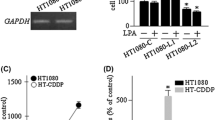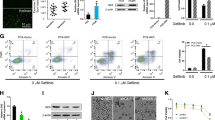Abstract
Lysophosphatidic acid (LPA) signaling through LPA receptors (LPA1 to LPA6) regulates a variety of malignant properties in cancer cells. Recently, we show that LPA2 expression is elevated by long-term cisplatin (CDDP) treatment in melanoma A375 cells. In the present study, we investigated whether LPA2-mediated signaling is involved in the modulation of chemoresistance in A375 cells. In cell survival assay, cells were treated with CDDP and dacarbazine (DTIC) every 24 h for 2 days. The cell survival rates to CDDP and DTIC were markedly increased by an LPA2 agonist, GRI-977143. To validate the effects of LPA2 on cell survival, LPA2 knockdown cells were generated from A375 cells. The cell survival rates elevated by GRI-977143 were suppressed by LPA2 knockdown. To evaluate the roles of LPA2-mediated signaling in cell survival, cells were pretreated with a Gi protein inhibitor, pertussis toxin (PTX). In the presence of GRI-977143, the cell survival rates to CDDP and DTIC were significantly lower in PTX-treated cells than in untreated cells. In addition, pretreatment of an adenylyl cyclase inhibitor, SQ22536, increased the cell survival of A375 cells treated with CDDP and DTIC. These results suggest that LPA2-mediated signaling plays an important role in the enhancement of chemoresistance of A375 cells treated with anticancer drugs.






Similar content being viewed by others
Abbreviations
- LPA:
-
Lysophosphatidic acid;
- LPA2 :
-
LPA receptor-2
- CDDP:
-
Cisplatin
- DTIC:
-
Dacarbazine
- ABC:
-
ATP-binding cassette
- GST:
-
Glutathione-S-transferase
- RT-PCR:
-
Reverse transcription-polymerase chain reaction
- PTX:
-
Pertussis toxin
References
Hamilton G, Rath BA (2014) A short update on cancer chemoresistance. Wine Med Wochenschr 164:456–460
Sau A, Tregno FP, Valentino F, Federici G, Caccuri AM (2010) Glutathione transferases and development of new principles to overcome drug resistance. Arch Biochem Biophys 500:116–122
Chen Z, Shi T, Zhang L, Zhu P, Deng M, Huang C, Hu T, Jiang L, Li J (2016) Mammalian drug efflux transporters of the ATP binding cassette (ABC) family in multidrug resistance: a review of the past decade. Cancer Lett 370:153–164
Kathawala RJ, Gupta P, Ashby CR Jr, Chen Z-S (2015) The modulation of ABC transporter-mediated multidrug resistance in cancer: a review of the past decade. Drug Resist Updat 18:1–17
Aikawa S, Hashimoto T, Kano K, Aoki J (2015) Lysophosphatidic acid as a lipid mediator with multiple biological actions. J Biochem 157:81–89
Stoddard NC, Chun J (2015) Promising pharmacological directions in the world of lysophosphatidic acid signaling. Biomol Ther 23:1–11
Yung YC, Stoddard NC, Chun J (2014) LPA receptor signaling: pharmacology, physiology, and pathophysiology. J Lipid Res 55:1192–1214
Lin M-E, Herr DR, Chun J (2010) Lysophosphatidic acid (LPA) receptors: Signaling properties and disease relevance. Prostaglandins Other Lipid Mediat 91:130–138
Tsujiuchi T, Araki M, Hirane M, Dong Y, Fukushima N (2014) Lysophosphatidic acid receptors in cancer pathobiology. Histol Histopathol 29:313–321
Takahashi K, Fukushima K, Onishi Y, Inui K, Node Y, Fukushima N, Honoki K, Tsujiuchi T (2017) Lysophosphatidic acid (LPA) signaling via LPA4 and LPA6 negatively regulates cell motile activities of colon cancer cells. Biochem Biophys Res Commun 483:652–657
Fukushima K, Takahashi K, Yamasaki E, Onishi Y, Fukushima N, Honoki K, Tsujiuchi T (2017) Lysophosphatidic acid signaling via LPA1 and LPA3 regulates cellular functions during tumor progression in pancreatic cancer cells. Exp Cell Res 352:139–145
Takahashi K, Fukushima K, Tanaka K, Minami K, Ishimoto K, Otagaki S, Fukushima N, Honoki K, Tsujiuchi T (2018) Involvement of LPA signaling via LPA receptor-2 in the promotion of malignant properties in osteosarcoma cells. Exp Cell Res 369:316–324
Minami K, Ueda N, Maeda H, Ishimoto K, Otagaki S, Tsujiuchi T (2019) Modulation of chemoresistance by lysophosphatidic acid (LPA) signaling through LPA5 in melanoma cells treated with anticancer drugs. Biochem Biophys Res Commun 517:359–363
Fukushima K, Takahashi K, Kurokawa A, Ishimoto K, Otagaki S, Minami K, Fukushima N, Honoki K, Tsujiuchi T (2018) Involvement of LPA receptor-5 in the enhancement of cell motile activity by phorbol ester and anticancer drug treatments in melanoma A375 cells. Biochem Biophys Res Commun 496:225–230
Kiss GN, Fells JI, Gupte R, Lee SCV, Liu J, Nusser N, Lim KG, Ray RM, Lin FT, Parrill AL, Sümegi B, Miller DD, Tigyi G (2012) Virtual screening for LPA2-specific agonist identifies a nonlipid compound with antiapoptotic actions. Mol Pharmacol 82:1162–1173
Shano S, Hatanaka K, Ninose S, Moriyama R, Tsujiuchi T, Fukushima N (2008) A Lysophosphatidic acid receptor lacking the PDZ-binding domain is constitutively active and stimulates cell proliferation. Biochim Biophys Acta 1783:748–759
Hourani SM, Boon K, Fooks HM, Prentice DJ (2001) Role of cyclic nucleotides in vasodilations of the rat thoracic aorta induced by adenosine analogue. Br J Pharmacol 133:833–840
Hei YJ, MacDonell KL, McNeill JH, Diamond J (1991) Lack of correlation between activation of cyclic AMP-dependent protein kinase and inhibition of contrtaction of rat vas deferens by cyclic AMP analogs. Mol Pharmacol 39:233–238
Takahashi K, Fukushima K, Fukushima N, Honoki K, Tsujiuchi T (2017) Enhanced cellular functions through induction of LPA2 by cisplatin in fibrosarcoma HT1080 cells. Mol Cell Biochem 431:29–35
Steegborn C (2014) Structure, mechanisms, and regulation of soluble adenylyl cyclases—similarities and differences to transmembrane adenylyl cyclases. Biochim Biophys Acta 1842:2535–2547
Arana MR, Tocchetti GN, Domizi P, Arias A, Rigalli JP, Ruiz ML, Luquita MG, Banchino C, Mottino AD, Villanueva SSM (2015) Coordinated induction of GST and MRP2 by cAMP in Caco-2 cells: role of protein kinase A signaling pathway and toxicological relevance. Toxicol Appl Pharmacol 287:178–190
Lee CW, Rivera R, Gardell S, Dubin AE, Chun J (2006) GPR92 as a new G12/13 and Gq coupled lysophosphatidic acid receptor that increases cAMP, LPA5. J Biol Chem 281:23589–23597
Lin ME, Rivera RR, Chun J (2012) Targeted deletion of LPA5 identifies novel roles for lysophosphatidic acid signaling in development of neuropathic pain. J Biol Chem 287:17608–17617
Cheepala S, Hulot J-S, Morgan JA, Sassi Y, Zhang W, Naren AP, Schuets JD (2013) Cyclic nucleotide compartmentalization: contributors of phosphodiesterases and ATP-binding cassette transporters. Annu Rev Pharmacol Toxicol 53:231–253
Samuel E, Moore M, Voskoboynik M, Shackleton M, Haydon A (2019) An update on adjuvant systemic therapies in melanoma. Melanoma Manag 6:MMT28
Acknowledgements
This work was supported by JSPS KAKENHI Grant No. JP18K07249 and by research grants from the Faculty of Science and Engineering, Kindai University.
Author information
Authors and Affiliations
Corresponding author
Ethics declarations
Conflict of interest
The authors declare that they have no conflict of interest.
Additional information
Publisher's Note
Springer Nature remains neutral with regard to jurisdictional claims in published maps and institutional affiliations.
Rights and permissions
About this article
Cite this article
Minami, K., Ueda, N., Ishimoto, K. et al. Lysophosphatidic acid receptor-2 (LPA2)-mediated signaling enhances chemoresistance in melanoma cells treated with anticancer drugs. Mol Cell Biochem 469, 89–95 (2020). https://doi.org/10.1007/s11010-020-03730-w
Received:
Accepted:
Published:
Issue Date:
DOI: https://doi.org/10.1007/s11010-020-03730-w




